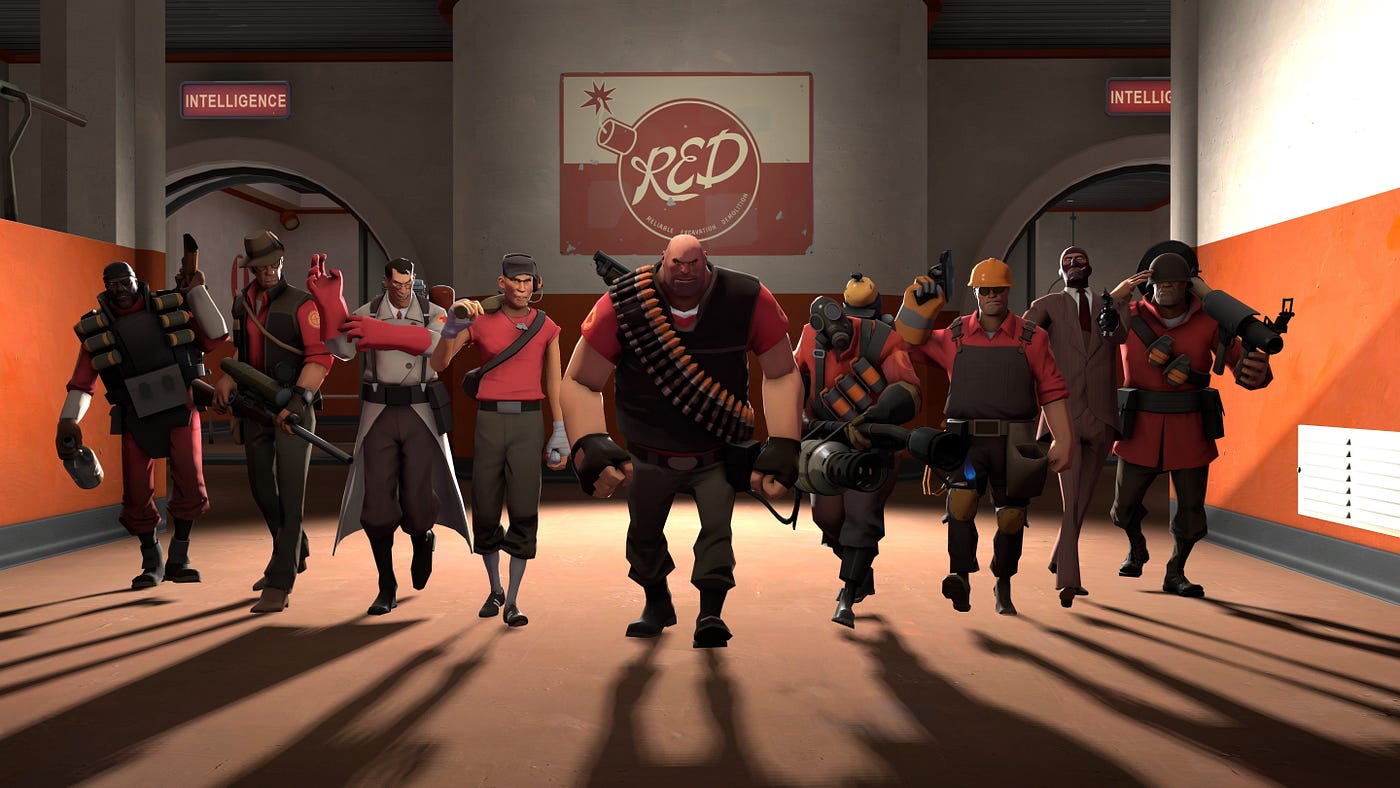The Unsinkable Team Fortress 2
Valve’s team-based FPS has outlasted a lot of competitors — but what comes next?

Everyone who plays Team Fortress 2 swears they’re a master Sniper, which is why I can never play one again. Not that I should play one — yes, I was once very good at clicking on heads, but at some point, my nerves became so jangly that I couldn’t go into the scope without mashing impulsively on the left mouse button.
In the name of not agitating my teammates on my first game back, I opt for the Medic, a class that I hope will not suffer for my lack of top-level technical skill. Moments later, I’m in the middle of a desperate defense in an area that I vaguely remember. All of my teammates are already half in the grave as they hold for dear life onto the objective and the air between me and them is about half incoming rockets. As I frantically try to keep everyone alive, I find myself flashing back on all of those Counter-Strike players who mocked TF2 for having characters who were too hard to kill.
In short, I found myself right back where I was the last time I played this game circa 2016 — panicked, frustrated, and surrounded by people who were probably aiming profanities at me. It’s online gaming the way it’s meant to be.

Team Fortress 2 is fast gaining a reputation as the game that cannot die, which is amusing as it has died many times, at least according to the community and the gaming press. Yet the game has enjoyed an unexpected renaissance in 2021, hitting a new record for concurrent users in June and maintaining an average player count well above what it had even after it went free-to-play. It has held a spot in Steam’s top ten most played games for ages, at times rivaling or even exceeding PUBG for player count.
All of that is pretty good for a game that’s over 14 years old. So what’s going on here, exactly? Were that this an easy question to answer, but the data on TF2 tell an odd story, one open to interpretation. The player count is certainly high, but who these people are is a mystery.
Explanations for the TF2 resurgence are numerous. Was the game rediscovered by streamers? Is it taking off in a region that didn’t have access before? Was it a pandemic hit? (Probably not since it was trending upwards in 2019, but 2020 was a big year for it) Is the game benefiting from the decline of direct competition such as Overwatch? Or is the growth an illusion fed by a fresh wave of bots? There’s no shortage of possibilities here, and it’s likely that more than one of these is correct.
There are two major factors that are hard to ignore. First, TF2 is free, and free games always have more mileage. Second, because of the game’s age, it can run quite well on low-end hardware. These two factors together make TF2 an extremely accessible game, especially in less affluent places. I’d add a third factor as well: As old as it is, TF2 has a pedigree that new free-to-play games can’t match. In a crowded marketplace where being noticed can be the hardest part, having over a decade’s worth of commentary is a great benefit.
In any case, with the game’s increased popularity holding steady, the question becomes: What does the future look like?
Adding to the unlikely late-life success of Team Fortress 2 is the messiness of its early years. The game that will never die was famously a game that was almost never born, with a development cycle of close to a decade that saw massive changes in graphics design and features over the years.
I first heard about TF2 in a magazine back around 2000, at a time when it was more rumor than fact and some people were already declaring it vaporware. This theoretical version of the game was an odd beast, with some particularly strange features. One proposition was the addition of a tenth leadership-oriented class for which the player would not enter the map, but instead survey the area with cameras and issue commands to the other players. Clearly, the developers were approaching this project with an experimental mindset.
I ended up following the progress of TF2 for a few years despite the fact that I had little interest in either first-person shooters or online games in general. It was the teamwork concept that drew me to it. Video games featuring teamwork between players were fairly rare in the 90’s — cooperative campaigns were just hitting the scene, but there were few titles that were specifically built around players working together. It was the first game I’d even heard of that promised to unify skill and strategy in this way.
Plenty of people have remarked upon the influence that the Team Fortress games have exercised on the industry — the character archetypes, aesthetic style, and a wide variety of design elements have shown up in other titles. But on a higher level, it’s likely that some entire subgenres wouldn’t exist without these games demonstrating that teamwork can make for a great game.
TF2 is not the only old game that’s been getting attention as of late. Last month, ubiquitous Steam library occupant Half-Life 2 (which itself had a record month for concurrent players not long ago) received an update to add new software support and fix bugs. The generally accepted explanation is that this is being done to ensure that the game runs well on the upcoming Steam Deck.
With its relatively low cost, portability and ease of use, the Steam Deck is a device meant to appeal to consumers outside of the usual PC gaming space. For many people, this will be their first real exposure to the world of computer games, and that means a lot of shopping sprees. After all, what good is a new piece of hardware without a library of software? And the advantage of Steam is that there are plenty of older, well-regarded games that can be had for pocket change. For this reason, the Steam Deck is going to be a boon for free-to-play games as well.
Will this include Team Fortress 2? It doesn’t strike me as the kind of game that would succeed on the platform — but then again, free looks good anywhere you go. With over 50 million people owning a copy of TF2 as of 2018, this may well push it to even greater heights. In a few years, I could say without exaggeration that 1% of the entire species has played the game.
Of course, there’s always a bit of a shock when a lot of new players enter an established game. It happened when TF2 went free-to-play, and I foresee a wave of grumpy FPS enthusiasts writing obituaries for the game in the not-so-distant future.
It takes a few matches to unlearn some of the habits I picked up in Overwatch. There are no barriers to hide behind, no one on my side is going to turn the tide of battle with an ultimate attack, and with no mandatory healers, death comes quicker. I have my job cut out for me.
There is something warmly familiar here, though. The camaraderie of the Heavy-Medic duo is something a little bigger than the mechanics suggest. You become a team of two within the larger team, one covering the weaknesses of the other. I watch the flank for opportunistic Spies, he tosses me a sandwich after I take a stray rocket. And yes, this camaraderie can turn into a special kind of frustration when the person playing the Heavy decides he’d rather be the team’s fourth ineffective Sniper, but that too is part of the experience.
I wonder how many of these “new” players are those who’ve just been out of the game for ages — who left for newer, prettier titles, only to find their way back to what works best. Like me, I imagine that they returned to discover a game that hasn’t changed, and yet looks different for the changes in their own lives.
Then again, maybe it’s just a fad.
